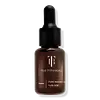What's inside
What's inside
 Key Ingredients
Key Ingredients

 Benefits
Benefits

 Concerns
Concerns

 Ingredients Side-by-side
Ingredients Side-by-side

Camellia Oleifera Seed Oil
Skin ConditioningVitis Vinifera Seed Oil
EmollientPersea Gratissima Oil
Skin ConditioningSclerocarya Birrea Seed Oil
HumectantCannabis Sativa Seed Oil
EmollientSalvia Hispanica Seed Oil
MoisturisingCitrullus Lanatus Seed Oil
EmollientBorago Officinalis Seed Oil
EmollientRosa Rubiginosa Seed Oil
EmollientRubus Idaeus Seed Oil
EmollientOenothera Biennis Oil
EmollientArgania Spinosa Kernel Oil
EmollientSqualane
EmollientCarica Papaya Seed Oil
HumectantActinidia Chinensis Seed Oil
EmollientPassiflora Incarnata Seed Oil
Skin ProtectingPassiflora Edulis Seed Oil
EmollientOlea Europaea Fruit Oil
MaskingSilybum Marianum Seed Oil
Skin ConditioningCinnamomum Camphora Leaf Extract
MaskingBoswellia Carterii Oil
MaskingCitrus Aurantium Amara Leaf/Twig Extract
Skin ConditioningTocopherol
AntioxidantVetiveria Zizanoides Root Oil
MaskingRosa Damascena Flower Oil
MaskingJasminum Officinale Oil
MaskingAbies Sibirica Oil
MaskingHaematococcus Pluvialis Extract
AntioxidantNannochloropsis Oculata Extract
HumectantPinus Densiflora Extract
AntioxidantPorphyra Umbilicalis Extract
Skin ConditioningRosmarinus Officinalis Extract
AntimicrobialLinalool
PerfumingCitronellol
PerfumingGeraniol
PerfumingFarnesol
PerfumingBenzyl Alcohol
PerfumingCitral
PerfumingEugenol
PerfumingBenzyl Benzoate
AntimicrobialLimonene
PerfumingCamellia Oleifera Seed Oil, Vitis Vinifera Seed Oil, Persea Gratissima Oil, Sclerocarya Birrea Seed Oil, Cannabis Sativa Seed Oil, Salvia Hispanica Seed Oil, Citrullus Lanatus Seed Oil, Borago Officinalis Seed Oil, Rosa Rubiginosa Seed Oil, Rubus Idaeus Seed Oil, Oenothera Biennis Oil, Argania Spinosa Kernel Oil, Squalane, Carica Papaya Seed Oil, Actinidia Chinensis Seed Oil, Passiflora Incarnata Seed Oil, Passiflora Edulis Seed Oil, Olea Europaea Fruit Oil, Silybum Marianum Seed Oil, Cinnamomum Camphora Leaf Extract, Boswellia Carterii Oil, Citrus Aurantium Amara Leaf/Twig Extract, Tocopherol, Vetiveria Zizanoides Root Oil, Rosa Damascena Flower Oil, Jasminum Officinale Oil, Abies Sibirica Oil, Haematococcus Pluvialis Extract, Nannochloropsis Oculata Extract, Pinus Densiflora Extract, Porphyra Umbilicalis Extract, Rosmarinus Officinalis Extract, Linalool, Citronellol, Geraniol, Farnesol, Benzyl Alcohol, Citral, Eugenol, Benzyl Benzoate, Limonene
Ingredients Explained
These ingredients are found in both products.
Ingredients higher up in an ingredient list are typically present in a larger amount.
Citral is a fragrance and used to add a lemon-like scent to products. It is both naturally found in plants and created synthetically. In plants, it is commonly occurring in lemon myrtle, lemongrass, lemon tea-tree, lemon verbena, and other citruses.
The EU mandates Citral be listed separately as a fragrance. It is a known allergen and may cause contact dermatitis. Citral can also used as a masking ingredient.
The term 'fragrance' is not regulated in many countries. In many cases, it is up to the brand to define this term. For instance, many brands choose to label themselves as "fragrance-free" because they are not using synthetic fragrances. However, their products may still contain ingredients such as essential oils that are considered a fragrance.
The term 'citral' is a collective term for two geometric isomers: geranial/Citral A and neral/Citral B.
Learn more about CitralCitronellol is used to add fragrance/parfum to a product. It is often derived from plants such as roses. In fact, it can be found in many essential oils including geranium, lavender, neroli, and more. The scent of Citronellol is often described as "fresh, grassy, and citrus-like".
Since the Citronellol molecule is already unstable, Citronellol becomes irritating on the skin when exposed to air.
Citronellol is a modified terpene. Terpenes are unsaturated hydrocarbons found in plants. They make up the primary part of essential oils.
Citronellol is not able to be absorbed into deeper layers of the skin. It has low permeability,
Citronellol is also a natural insect repellent.
Learn more about CitronellolEugenol is naturally found in cloves, basil, and bay leaves. It is an aromatic oil used to add fragrance to a product. The scent of eugenol is described as "clove-like". Eugenol is a known EU allergen, meaning it causes contact allergies.
Studies show eugenol possesses antibacterial and antioxidant properties.
Besides cosmetics, eugenol is also added as a flavor in teas and cakes.
Learn more about EugenolFarnesol is a compound extracted from essential oils such as lemongrass, rose, and more. It is used as a fragrance in products to help boost floral scents.
Farnesol is a known EU allergen and causes contact dermatitis.
This ingredient is hydrophobic, meaning it is not soluble in water.
Learn more about FarnesolGeraniol is used to add fragrance/parfum to a product. It is the main component of citronellol. It is a monoterpenoid and an alcohol.
Monoterpenes are naturally found in many parts of different plants.
Geraniol can be found in many essential oils including Rose Oil and Citronella Oil. The scent of Geraniol is often described as "rose-like". Many foods also contain Geraniol for fruit flavoring.
Geraniol can irritate the skin when exposed to air. However, irritation depends on the ability of geraniol to penetrate into the skin. In general, geraniol is not able to penetrate skin easily.
Geraniol is colorless and has low water-solubility. However, it is soluble in common organic solvents.
Like citronellol, it is a natural insect repellent.
2,6-Octadien-1-ol, 3,7-dimethyl-, (2E)-
Learn more about GeraniolLimonene is a fragrance that adds scent and taste to a formulation.
It's found in the peel oil of citrus fruits and other plants such as lavender and eucalyptus. The scent of limonene is generally described as "sweet citrus".
Limonene acts as an antioxidant, meaning it helps neutralize free radicals.
When exposed to air, oxidized limonene may sensitize the skin. Because of this, limonene is often avoided by people with sensitive skin.
The term 'fragrance' is not regulated in many countries. In many cases, it is up to the brand to define this term. For instance, many brands choose to label themselves as "fragrance-free" because they are not using synthetic fragrances. However, their products may still contain ingredients such as essential oils that are considered a fragrance.
Learn more about LimoneneLinalool is a fragrance and helps add scent to products. It's derived from common plants such as cinnamon, mint, citrus, and lavender.
Like Limonene, this ingredient oxidizes when exposed to air. Oxidized linalool can cause allergies and skin sensitivity.
This ingredient has a scent that is floral, spicy tropical, and citrus-like.
Learn more about Linalool